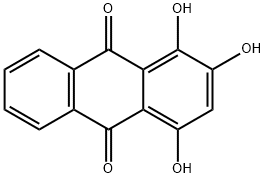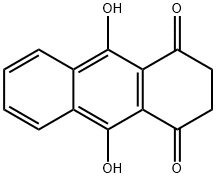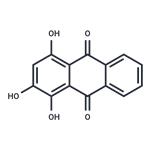Chemical Properties
brown-red to brown powder
Uses
Purpurin is an anthraquinone derivative and is well known as a colour pigment derived from madder plants. Purpurin was extensively utilized in herbal remedies, in food colouring and dyes for cotton pr
inting. Due to the high antioxidant activity exhibited by anthraquinone compounds, purpurin was determined through studies to possess potential radical scavenging effects. Purprin has also been shown
to have inhibitory effects towards serine protease.
Uses
A xanthine oxidase inhibitor.
Uses
xanthin oxidase inhibitor, irritant
Uses
Purpurin is a naturally occurring reddish-yellow pigment found in madder root (R. tinctorum) that has been used both in herbal remedies and as food coloring. It can also by synthetically derived from 9,10-anthraquinone. Purpurin is protective against a number of food-derived heterocyclic amines in bacterial mutagenicity assays through its inhibition of CYP450-dependent N-hydroxylation and reduction of N-hydroxylamines. Purpurine can also inhibit (IC50 = 6.6 μM) spermidine-induced autoactivation of plasma hyaluronan-binding protein, a serine protease that can activate coagulation factor VII and prourokinase.
Definition
ChEBI: A trihydroxyanthraquinone derived from anthracene by substitution with oxo groups at C-9 and C-10 and with hydroxy groups at C-1, C-2 and C-4.
Purification Methods
Crystallise purpurin from aqueous EtOH, dry it at 100o. [Beilstein 8 IV 3568.]





